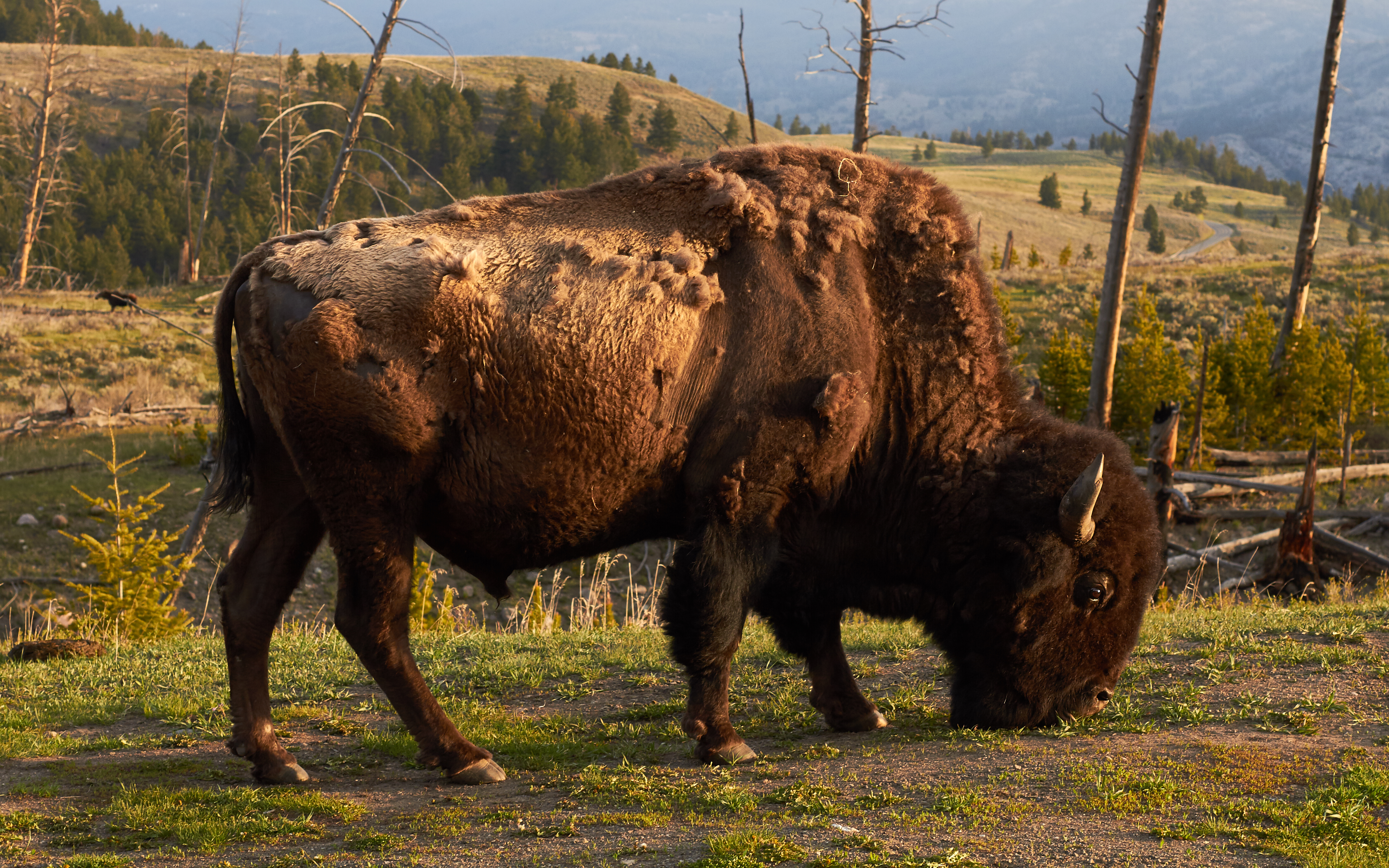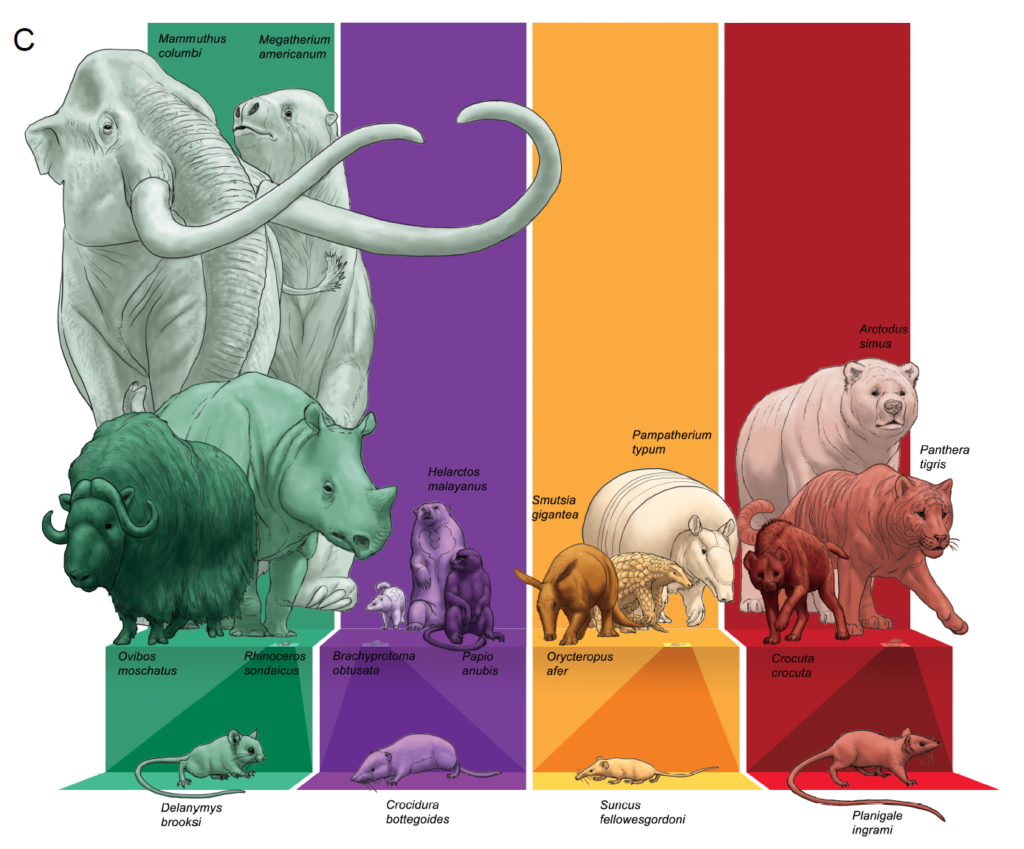A pattern that existed since the age of dinosaurs is now disappearing—with profound implications for ecosystems
by Christian Elliott, Northwestern University

Sitting on couches at an Airbnb in Montreal for the 2018 Marine World Conference, Jon Lefcheck, the Coordinating Scientist for the MarineGEO program at the Smithsonian Environmental Research Center, and his colleagues started tossing around the sort of questions scientists do in their free time. Questions like, is there a general pattern between what animals eat and how big they are?
Four years later, that conversation has culminated in a new study in Nature Ecology & Evolution, with the most comprehensive analysis yet of the relationship between vertebrate animals’ body sizes and their places on the food chain. The study reaches across taxonomic groups, ecosystems and 150 million years of evolutionary history. Humans, they found, are starting to disrupt a longstanding balance.
A timeless hourglass
The scientists found an hourglass-shaped pattern. Herbivores and carnivores skewed large at either end of the spectrum, with omnivores and invertivores coming up smaller in the middle, on average.
“Herbivores eat food that’s not terribly nutritious, so they have to be big to get around so they can eat a lot. And so their intestines get large to maximize the nutrients they get from poor food,” Lefcheck said. “And on the flip side, in order to take down big animals you have to be big yourself. So, carnivores also converge on large body sizes.”
Past studies had theorized about the hourglass or U-shaped curve. But this is the first to show how truly ubiquitous the pattern is. Lead authors William Gearty, a paleontologist at the University of Nebraska-Lincoln, and Rob Cooke, an ecological modeler at the UK Centre for Ecology and Hydrology, pulled together and analyzed the datasets. They considered 5,427 species of fossilized mammals, from the Early Cretaceous to the present (about 150 million years). The pair also looked at 5,033 present-day mammals plus 19,142 birds, reptiles and fishes. They looked across biomes—deserts, the Arctic, and oceans—and found the pattern held true for all vertebrates everywhere and across time, with few exceptions.
And the few exceptions have clear explanations. Take whales, for example. They’re essentially huge invertivores. But as marine mammals they have to be big to avoid losing too much heat into the water.
“It’s pretty exciting that this kind of relationship that was thought to be somewhat fundamental in mammals is actually much more fundamental than we thought,” said Gearty. “It spans all of these different scales—spatial, temporal and biological.”
Cooke agreed. “In ecology, it’s always messy,” he said. “There are very few ecological laws. And this seems like quite a generalized assembly rule found in all these different taxonomic groups, and that’s very rare.”
Meanwhile, Lefcheck and his colleagues, such as those from the Reef Life Survey network, played a key role ensuring the more land-focused ecologists on the team didn’t neglect marine ecosystems—helping prove how widespread the pattern is.

Given the patterns’ persistence over millions of years, the team decided to look forward at how human activity may affect the planet’s ecology. Cooke ran simulations 500 years into the future using a new extinction forecast simulator. He found a concerning trend. With future extinctions, maximum and median body size of herbivores and carnivores will shrink, resulting in an unprecedented “flattening” of the hourglass or U-shaped curve.
That’s mainly due to human activity. Environmental factors like climate change aren’t selective—they affect animals across the hourglass equally. However, humans are another matter.
“Humans are very selective in their pressures,” Lefcheck pointed out. “We want to get the big meaty fish. We want to hunt the big elephants. And those are the activities that are shifting the size distribution away from what it has been historically.”
“In the future, we’re pushing this system away from the shape we’ve seen for millions of years,” Cooke said.
Cracks in the hourglass
Humans have driven large herbivores and carnivores to extinction before (think mammoths at the end of the last Ice Age). Megafaunal extinctions back then caused massive changes in vegetation structure, fire regimes and nutrient cycling across ecosystems. That’s because large mammals play a key role in food webs, as they move nutrients and seeds across vast distances by eating plants and defecating.
“When you start to limit the ability to move that energy around, these ecosystems become increasingly isolated and less connected,” Lefcheck said. He calls megafauna “movers and shakers of energy.”
“I think we can safely say that the blunting of this U-shape, the removal of these large-body organisms, is going to have pretty substantial effects,” he added.
The study also has implications for the way we list organisms as endangered. The IUCN Red List accounts for species individually. It doesn’t consider the possible extinction of a large carnivore due to the extinction of an herbivore it preys upon. That’s because ecologists tend to specialize on a particular species group, and because unraveling the natural world’s relationship-based complexity is difficult. Some listings mention availability of food, but they don’t directly link species together. The authors say looking at endangered species in isolation is not good enough, given the pattern they found.
“If extinctions happen on the scale we’re seeing in the predictions, then there’s likely to be a lot more co-extinctions than are currently accounted for on the Red List,” Cooke said.
The million-dollar question is, according to Lefcheck, what will the ecosystem-level effects of losing large herbivores and carnivores be?
Research at the Smithsonian Environmental Research Center can begin to fill that gap. Lefcheck is the Tennenbaum Coordinating Scientist for the Marine Global Earth Observatory (MarineGEO) network, headquartered at the center. MarineGEO looks at coastal ecosystems all around the globe, with a special focus on biodiversity and food webs. By keeping tabs on ocean food webs globally, MarineGEO sites can act as harbingers of what is to come.
Go Deeper:
Global “BiteMap” Reveals How Marine Food Webs May Change With Climate
Could Algae-Eating Sea Urchins Save Coral Reefs?
Biodiversity Makes Reefs Tick—But It Needs Big Players

